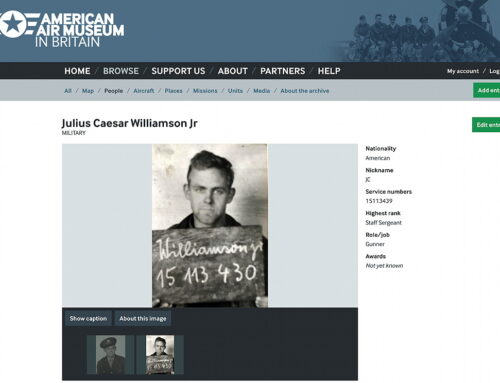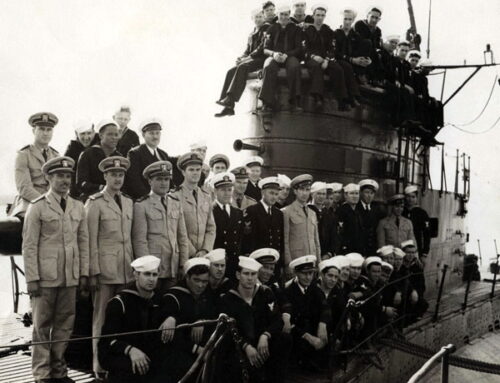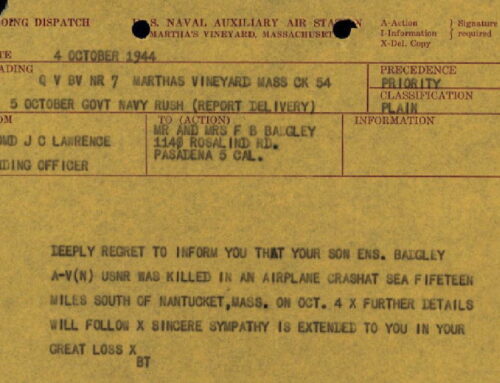The USS Oklahoma Project has concluded. Of the 429 killed on this battleship when the Japanese attacked Pearl Harbor 80 years ago today, 394 had been buried as unknown service members. Now 346 of those unknowns have been identified.
The Loss of the USS Oklahoma
During the December 7th attack, several torpedoes from Japanese warplanes hit the Oklahoma, capsizing the battleship and trapping most of the officers and crew below decks. The archival image above shows the capsized Oklahoma in the foreground. The battleship USS Maryland is behind the Oklahoma; the battleship USS West Virginia is on the right. (Photo courtesy National Archives.)
Recovery of Oklahoma Remains
According to this article at the Department of Defense website:
From December 1941 to June 1944, Navy personnel recovered the remains of the crew; they were interred in the Halawa and Nu’uanu cemeteries in Hawaii.
In September 1947, tasked with recovering and identifying fallen U.S. personnel in the Pacific Theater, members of the Army’s American Graves Registration Service disinterred the remains of U.S. dead from the two cemeteries and transferred them to the Central Identification Laboratory at Schofield Barracks, Hawaii. At that time, the laboratory staff was only able to confirm the identifications of 35 men from the USS Oklahoma.
The remaining USS Oklahoma Unknowns were placed in 62 caskets and buried in 46 plots at the National Memorial Cemetery of the Pacific, in Honolulu.
A Theory is Tested
The USS Oklahoma Project began with a theory. Ray Emory, a Pearl Harbor survivor, conducted research at the request of a family who had lost an Oklahoma Sailor. Emory found records that indicated at least one set of remains from the ship could be individually identified, if the remains could be disinterred for a thorough forensic examination. DPAA notes on its website:
In 2003, one of the 62 caskets containing remains from the USS Oklahoma was disinterred from the Punchbowl to conduct analysis on the remains to test Emory’s assertions…. The staff analyzed the remains using the latest technology and concluded that they came from more than 100 individuals, giving a good indication of the extent that remains from the ship were commingled during previous handling and identification attempts.
The laboratory made its first individual identification from the remains in that single casket in 2008, ultimately identifying a total of five Sailors from that casket between 2008 and 2010.
The laboratory was also able to identify one more USS Oklahoma Sailor in 2007 by identifying a single set of Unknown remains that had been found in the waters of Pearl Harbor and buried individually. That disinterment was also based on research conducted by Emory.
In 2012, based on the information and experience gained through those six identifications, the Joint POW/MIA Accounting Command … put forth a proposal to disinter the remaining 61 caskets of USS Oklahoma unknowns in hopes of finding the 377 Sailors and 11 Marines who remained unaccounted for.
USS Oklahoma Project

A USS Oklahoma Project researcher updates the photo of Navy Fireman 1C Billy James Johnson, the 200th service member to be identified from USS Oklahoma Unknowns. (US Air Force photo by Staff Sgt. Nicole Leidholm)
The USS Oklahoma Project – a special six-year project by the Defense POW/MIA Accounting Agency (DPAA) – began with the exhumation of all remaining Oklahoma Unknowns from the Punchbowl Cemetery in 2015.
Their website notes “DPAA anthropologists and odontologists, located primarily at Offutt Air Force Base, Nebraska, have worked to sort and analyze over 13,000 bones and associate them to missing Sailors and Marines. Genealogists from the Navy and Marine Corps Casualty Offices conducted research to find family members so that DNA testing could be conducted by scientists at the Armed Forces Medical Examiner System, all of which were critical components in the identification process.”
Now 346 USS Oklahoma sailors have reached their final resting places with their families.
Reinterment of Oklahoma Unknowns
The remaining Oklahoma Unknowns were returned from Nebraska with full military honors. Today they reached their final resting place. The reinterment of the USS Oklahoma Unknowns at the National Cemetery of the Pacific may be viewed here.
It is good when the lost come home.





Leave a Reply